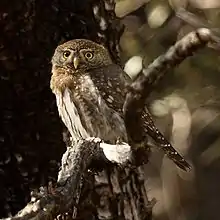Mountain pygmy owl
The mountain pygmy owl (Glaucidium gnoma) is a small owl from Central America. It is considered a distinct species by some authorities, including the International Ornithologists' Union. Others, including the American Ornithological Society, consider to be a subspecies of northern pygmy owl. If considered conspecific, the scientific name G. gnoma is usurped by the northern pygmy owl. The Northern Mountain Pygmy Owls’ habitats range from coniferous forests to deciduous bottomlands, and despite its large geographic distribution, “it is one of the least studied owls on the continent” (Holt & Peterson 2000). Its diet consists of small birds and mammals, and it has a reputation of being a fierce hunter. This species of owl will nest in natural cavities and in ones created by woodpeckers (Holt & Peterson 2000). In a study conducting research on Northern Mountain Pygmy Owls preferred habitats in the Rocky Mountains, it was discovered to prefer large diverse forests with trees near a stream because it offered protection from predators and camouflage for ambush attacks (Jageman et. al. 2018).
| Mountain pygmy owl | |
|---|---|
 | |
| Scientific classification | |
| Kingdom: | Animalia |
| Phylum: | Chordata |
| Class: | Aves |
| Order: | Strigiformes |
| Family: | Strigidae |
| Genus: | Glaucidium |
| Species: | G. gnoma |
| Binomial name | |
| Glaucidium gnoma Wagler, 1832 | |
 | |
References
- BirdLife International (2016). "Glaucidium gnoma". The IUCN Red List of Threatened Species. IUCN. 2016: e.T61791135A95180896. doi:10.2305/IUCN.UK.2016-3.RLTS.T61791135A95180896.en. Retrieved 15 January 2018.
- Duncan, James R. (2003) Owls of the World: Their Lives, Behavior and Survival. Firefly Books
- Holt, D.W., and J.L. Peterson. “Northern Pygmy-Owl (Glaucidium Gnoma).” Northern
Pygmy-Owl - Introduction | Birds of North America Online, Cornell Lab of Ornithology, Ithaca, NY, USA, 2000, birdsna.org/Species-Account/bna/species/nopowl.
- Jageman, Harry R., et al. “Habitat Selection by Northern Pygmy-Owls in the Rocky Mountains.”
Journal of Raptor Research, Raptor Research Foundation, 1 Sept. 2018,
